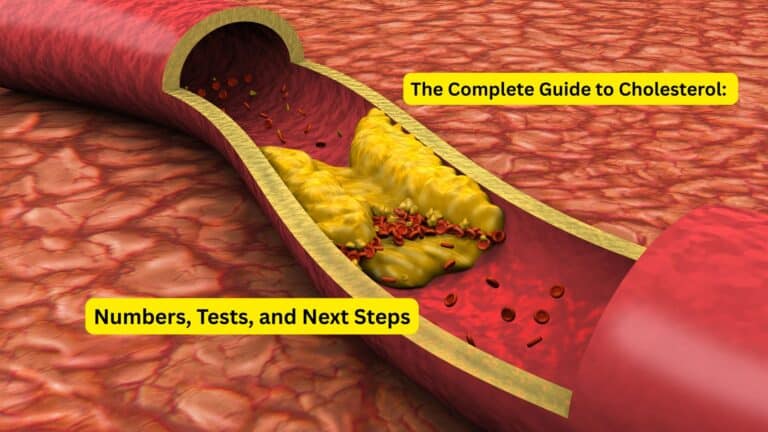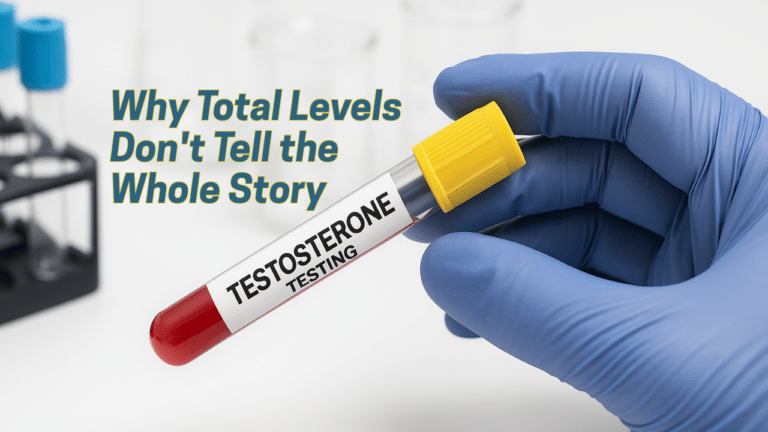Cholesterol often sparks confusion and concern among patients, with many people unsure whether it’s harmful or necessary for their health. The truth is that cholesterol serves essential functions in your body, including hormone production, cell membrane maintenance, and bile acid formation for digestion. However, the story becomes more complex when considering how different types of cholesterol—HDL, LDL, and triglycerides—affect your cardiovascular risk in distinctly different ways.
Understanding these different cholesterol components and their individual roles empowers you to interpret your lab results meaningfully and take appropriate action for your heart health. This comprehensive guide will clarify the confusion surrounding cholesterol, explain why regular testing matters, and provide practical strategies for managing your lipid profile to reduce cardiovascular disease risk.
What Is Cholesterol?
Cholesterol represents a waxy, fat-like substance that your body produces naturally and also obtains from certain foods in your diet. Far from being purely harmful, cholesterol plays vital roles in hormone production, cell membrane structure, and digestive processes throughout your body. Your liver manufactures approximately 75% of the cholesterol in your bloodstream, while dietary sources contribute the remaining 25%.
Because cholesterol cannot dissolve in water-based blood, it travels through your circulatory system packaged in special carriers called lipoproteins. These protein-wrapped particles transport cholesterol and other fats to and from various tissues where they’re needed for cellular functions. The density and composition of these lipoproteins determine whether they contribute to cardiovascular protection or increase disease risk.
Understanding how cholesterol moves through your bloodstream helps explain why different types have such dramatically different effects on your health. The lipoprotein carriers essentially act as delivery vehicles, with some types depositing cholesterol in dangerous locations while others help remove excess cholesterol from problem areas.
Types of Cholesterol: The Good and the Bad
The relationship between different cholesterol types becomes clearer when you understand their distinct functions and destinations within your cardiovascular system. While your total cholesterol number provides some useful information, the individual components of your lipid profile tell a much more detailed story about your heart disease risk. These different cholesterol fractions work in opposing ways, making it essential to evaluate each component rather than focusing solely on total levels.
HDL Cholesterol
High-density lipoprotein (HDL) cholesterol earns its reputation as “good” cholesterol through its protective role in cardiovascular health. HDL particles function like a cleanup crew, removing excess cholesterol from artery walls and transporting it back to the liver for processing and elimination from the body. This reverse cholesterol transport system helps prevent the accumulation of dangerous plaque deposits in your arteries.
Higher HDL levels correlate with lower cardiovascular disease risk, as these particles actively work to maintain clear, healthy arteries. HDL cholesterol also possesses anti-inflammatory properties that help protect blood vessel walls from damage and reduce the likelihood of plaque rupture that can trigger heart attacks or strokes.
Women typically maintain higher HDL levels than men, partly due to estrogen’s protective effects on cholesterol metabolism. However, both men and women benefit significantly from lifestyle modifications that can raise HDL levels, including regular aerobic exercise, moderate alcohol consumption (if appropriate), and maintaining a healthy weight.
LDL Cholesterol
Low-density lipoprotein (LDL) cholesterol becomes problematic when levels remain elevated over time, leading to its designation as “bad” cholesterol. LDL particles carry cholesterol from the liver to peripheral tissues, but when present in excessive amounts, they can infiltrate artery walls and contribute to atherosclerotic plaque formation.
The process of LDL-induced plaque development occurs gradually over years or decades, with cholesterol deposits accumulating in artery walls and eventually narrowing blood vessels. These plaques can become unstable and rupture, triggering blood clot formation that blocks circulation and causes heart attacks or strokes.
Different LDL particle sizes affect cardiovascular risk, with small, dense LDL particles proving more dangerous than larger, fluffier particles. Advanced lipid testing can sometimes identify these particle characteristics, providing additional information for personalized risk assessment and treatment strategies.
Triglycerides
Triglycerides represent the most common type of fat in your body, serving as an energy storage system for excess calories from any source—carbohydrates, proteins, or fats. While normal triglyceride levels pose no health risks, elevated levels often signal metabolic problems and increase cardiovascular disease risk, especially when combined with low HDL or high LDL cholesterol.
High triglyceride levels frequently accompany insulin resistance, metabolic syndrome, and type 2 diabetes, creating a cluster of risk factors that dramatically elevate heart disease likelihood. Very high triglyceride levels (above 500 mg/dL) can also trigger acute pancreatitis, a serious inflammatory condition affecting the pancreas.
Gender differences in triglyceride metabolism mean that elevated levels may pose different risks for men versus women, with some research suggesting that high triglycerides present greater cardiovascular risks for women than previously recognized.
Why Cholesterol Matters for Heart Health
The connection between cholesterol and cardiovascular disease centers on the process of atherosclerosis, where cholesterol-containing plaques gradually accumulate in artery walls and restrict blood flow to vital organs. This progressive narrowing affects not only coronary arteries supplying the heart but also cerebral arteries feeding the brain and peripheral arteries serving the limbs. Understanding this process helps explain why cholesterol management becomes so crucial for preventing heart attacks, strokes, and other cardiovascular events.
Lipid panel testing provides comprehensive risk assessment by evaluating multiple components simultaneously, rather than focusing on any single measurement. The interplay between HDL, LDL, and triglycerides creates complex risk patterns that require careful interpretation to guide appropriate prevention or treatment strategies.
The timing of plaque rupture remains unpredictable, with some people developing symptoms from relatively stable plaques that gradually narrow arteries, while others experience sudden cardiac events when unstable plaques rupture unexpectedly. This unpredictability emphasizes the importance of preventing plaque formation through optimal cholesterol management rather than waiting for symptoms to develop.
Gender differences in lipid metabolism and cardiovascular risk patterns mean that the same cholesterol numbers may indicate different risk levels for men versus women. Women often develop cardiovascular disease later in life but may have different symptom presentations and risk factor profiles that require specialized consideration during evaluation and treatment.
Long-term cholesterol elevation affects not only major arteries but also smaller blood vessels throughout the body, potentially contributing to kidney disease, cognitive decline, and peripheral circulation problems that can significantly impact quality of life even when they don’t cause immediate life-threatening events.
Cholesterol Testing & Interpreting Results
Cholesterol testing provides the foundation for cardiovascular risk assessment and treatment decisions, making it essential to understand what different tests measure and how to interpret the results. Modern lipid panels evaluate multiple components simultaneously, providing a comprehensive picture of your cholesterol status that guides both immediate decisions and long-term monitoring strategies. The timing and preparation for these tests can significantly affect accuracy, making proper preparation crucial for reliable results.
Lipid Panel Basics
A complete lipid panel measures total cholesterol, HDL cholesterol, LDL cholesterol, and triglycerides in a single blood draw, typically requiring 8-12 hours of fasting before the test for accurate triglyceride measurement. Recent guidelines have relaxed fasting requirements in some situations, but fasting samples remain preferred for initial assessments and monitoring treatment responses.
The laboratory calculates LDL cholesterol using a formula that incorporates total cholesterol, HDL cholesterol, and triglycerides, though direct LDL measurement becomes necessary when triglycerides exceed 400 mg/dL. Some advanced lipid panels also measure additional components like lipoprotein(a), apolipoprotein B, or LDL particle number for more detailed risk assessment.
Understanding the limitations of calculated LDL values helps explain why some patients may need repeat testing or alternative measurement methods, particularly those with very high triglycerides or unusual lipid patterns that affect calculation accuracy.
Optimal Levels
Current guidelines recommend specific target ranges for each lipid component based on extensive research linking these levels to cardiovascular outcomes. LDL cholesterol should ideally remain below 100 mg/dL for most people, with even lower targets (below 70 mg/dL) recommended for those at high cardiovascular risk.
HDL cholesterol targets differ by gender, with levels of 40 mg/dL or higher considered adequate for men and 50 mg/dL or higher for women, though higher levels provide additional protection. Triglycerides should stay below 150 mg/dL, with levels between 150-199 mg/dL considered borderline high and those above 200 mg/dL indicating elevated risk.
Total cholesterol levels below 200 mg/dL are generally desirable, though this number becomes less meaningful than the individual components, particularly the ratio between HDL and LDL cholesterol. Some people with high total cholesterol due to very high HDL levels may actually have excellent cardiovascular risk profiles.
Non-HDL Cholesterol
Non-HDL cholesterol, calculated by subtracting HDL from total cholesterol, has emerged as an important risk marker that may provide better cardiovascular risk prediction than LDL cholesterol alone. This measurement captures all potentially harmful cholesterol particles, including LDL, VLDL (very low-density lipoprotein), and other atherogenic lipoproteins.
Target non-HDL cholesterol levels should remain 30 mg/dL higher than your LDL target, providing a more comprehensive assessment of cholesterol-related cardiovascular risk. This measurement becomes particularly valuable for people with high triglycerides, diabetes, or metabolic syndrome, where traditional LDL calculations may underestimate risk.
Recent research suggests that non-HDL cholesterol may better predict cardiovascular events than LDL cholesterol in certain populations, leading to increased emphasis on this measurement in clinical guidelines and risk assessment tools.
Managing Cholesterol: Lifestyle and Treatment
Effective cholesterol management requires a comprehensive approach that combines evidence-based lifestyle modifications with appropriate medical treatment when necessary. The most successful strategies address multiple aspects of lipid metabolism simultaneously while considering individual risk factors, preferences, and health conditions. Understanding both lifestyle interventions and medical treatments enables patients to work collaboratively with healthcare providers to develop personalized management plans.
Lifestyle Interventions
Dietary modifications represent the cornerstone of cholesterol management, with Mediterranean-style eating patterns demonstrating particular effectiveness for improving lipid profiles. These approaches emphasize olive oil, nuts, fish, fruits, vegetables, and whole grains while limiting saturated fats, trans fats, and refined carbohydrates that can worsen cholesterol levels.
Reducing saturated fat intake to less than 7% of total calories and eliminating trans fats completely can significantly lower LDL cholesterol within weeks of dietary changes. Soluble fiber from sources like oats, beans, and barley helps bind cholesterol in the digestive tract and prevent absorption, providing additional LDL-lowering benefits.
Regular physical activity offers multiple lipid benefits, including raising HDL cholesterol, lowering triglycerides, and potentially improving LDL particle size distribution. Aerobic exercise proves most effective for these improvements, though resistance training also contributes to overall cardiovascular health and weight management.
Weight management becomes crucial for people with elevated triglycerides or low HDL cholesterol, as excess body weight—particularly abdominal fat—disrupts normal lipid metabolism and promotes insulin resistance that worsens lipid profiles.
Medications
Statin medications remain the primary treatment for elevated LDL cholesterol, with extensive research demonstrating their effectiveness for reducing cardiovascular events across diverse patient populations. These medications work by inhibiting cholesterol synthesis in the liver, leading to increased LDL receptor production and enhanced cholesterol removal from the bloodstream.
Different statin medications vary in potency and duration of action, allowing healthcare providers to select appropriate options based on individual patient needs, target cholesterol levels, and potential side effects. Some patients may require combination therapy with additional medications like ezetimibe, PCSK9 inhibitors, or bile acid sequestrants to achieve optimal LDL levels.
For elevated triglycerides, fibrates, omega-3 fatty acid supplements, or niacin may be recommended, either alone or in combination with statins. These medications work through different mechanisms and may be particularly beneficial for patients with metabolic syndrome or diabetes.
Prevention
Regular monitoring through lipid panel testing enables early detection of cholesterol problems before they contribute to cardiovascular disease, making prevention strategies more effective than waiting for symptoms or complications to develop. The frequency of testing depends on individual risk factors, family history, and previous results.
Family history of early cardiovascular disease or genetic lipid disorders may warrant more aggressive monitoring and treatment approaches, as inherited conditions can cause severely elevated cholesterol levels despite healthy lifestyle choices. Genetic testing for familial hypercholesterolemia may be appropriate for people with very high cholesterol levels or strong family histories.
Understanding personal risk factors beyond cholesterol, including blood pressure, diabetes, smoking, and inflammatory markers, helps create comprehensive prevention strategies that address multiple cardiovascular risk pathways simultaneously.
Practical Steps for Consumers
Taking control of your cholesterol management requires consistent action across multiple areas, from regular monitoring to lifestyle implementation and healthcare communication. Walk-In Lab’s accessible testing services remove common barriers to regular lipid monitoring, enabling proactive management before problems develop or worsen. Combining convenient testing with evidence-based lifestyle changes creates a powerful prevention strategy that can significantly reduce cardiovascular disease risk over time.
Regular lipid panel testing through Walk-In Lab provides the objective data needed to track your progress and guide decision-making about lifestyle changes or medical treatment. The convenience and affordability of direct-access testing enable more frequent monitoring than traditional healthcare visits might allow, particularly valuable when implementing new interventions or adjusting medications.
Combining cholesterol testing with other cardiovascular risk assessments, such as blood pressure monitoring, diabetes screening, and inflammatory marker evaluation, provides a comprehensive picture of your overall heart health status. This broader assessment helps identify multiple risk factors that may work together to increase cardiovascular disease likelihood.
Early detection and intervention prove far more effective than waiting for symptoms or complications to develop, as advanced atherosclerotic disease becomes much more difficult to reverse once established. Regular testing enables you to catch problems in their early stages when lifestyle modifications and preventive treatments offer the greatest benefits.
Working with healthcare providers to interpret your results and develop personalized management strategies ensures that your efforts align with current medical evidence and address your specific risk profile effectively.
FAQs
What is cholesterol and why do I need it?
Cholesterol is a waxy substance your body needs for making hormones, building cell membranes, and producing bile acids for digestion. Your liver produces most of your body’s cholesterol naturally. While essential for normal body function, problems arise when you have too much of certain types, particularly LDL cholesterol that can build up in arteries and increase heart disease risk.
What’s the difference between HDL and LDL?
HDL (high-density lipoprotein) is “good” cholesterol that removes excess cholesterol from your arteries and transports it to your liver for disposal. LDL (low-density lipoprotein) is “bad” cholesterol that can deposit in artery walls and contribute to plaque buildup. Think of HDL as a cleanup crew and LDL as potential troublemakers when present in excess amounts.
Why are triglycerides important?
Triglycerides store excess energy from food as fat in your body. High triglyceride levels often indicate metabolic problems and increase cardiovascular risk, especially when combined with low HDL or high LDL cholesterol. Very high triglycerides can also cause pancreatitis, a serious inflammatory condition affecting your pancreas.
How can I lower bad cholesterol?
Effective strategies include adopting a Mediterranean-style diet rich in fruits, vegetables, whole grains, and healthy fats while limiting saturated and trans fats. Regular exercise, maintaining healthy weight, and not smoking all help improve your lipid profile. Some people also need medications like statins to reach optimal LDL levels, particularly those with genetic predisposition or multiple risk factors.
How often should I get a cholesterol test?
Testing frequency depends on your risk factors and current levels. Adults with normal cholesterol should test every 4-5 years, while those with elevated levels, family history, or other cardiovascular risks may need annual or more frequent testing. People taking cholesterol medications typically need testing every 6-12 weeks initially, then every 3-6 months once levels stabilize.
Conclusion
Understanding your cholesterol numbers provides essential insight into your cardiovascular health and empowers you to take proactive steps toward heart disease prevention. The distinction between HDL, LDL, and triglycerides helps explain why total cholesterol alone doesn’t tell the complete story about your risk profile. Regular monitoring through lipid panel testing enables early detection of problems and provides objective feedback on the effectiveness of your prevention efforts.
The good news is that cholesterol management remains largely within your control through lifestyle choices like diet, exercise, weight management, and avoiding tobacco. When combined with appropriate medical treatment for those who need it, these interventions can dramatically reduce cardiovascular disease risk and improve long-term health outcomes. The key lies in taking action before symptoms develop, when prevention strategies prove most effective.
Don’t wait to understand your cardiovascular risk profile. Order a Lipid Panel Test today with Walk-In Lab to get comprehensive information about your HDL, LDL, and triglyceride levels, and take the first step toward optimal heart health through informed prevention and management.
This article is for informational purposes only and does not constitute medical advice. Always consult with healthcare professionals for personalized medical guidance and treatment recommendations.






